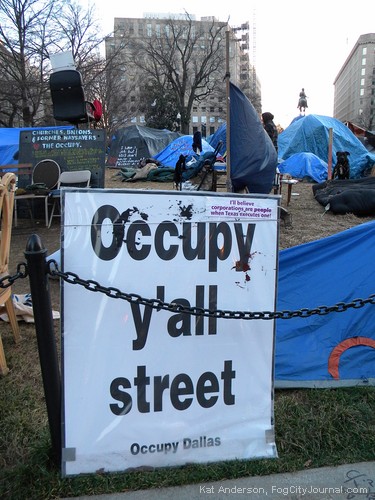
A Texas protester brought a downhome message to Occupy DC in McPherson Square, a public park in the nation's capital just a few blocks from the White House. Photos by Kat Anderson.
By Carl T. Hall and Kat Anderson, reporting from Washington, D.C.
February 3, 2012
Washington, D.C. has become a mecca for Occupy protesters kicked out of their camps in other cities around the country.
Robert Dilley, a 26-year-old activist from New Jersey, recalled being run out of Zuccotti Park where the Occupy Wall Street phenomenon started. He found it tough living out on the streets of Manhattan.
After leaving the New York protest camp, he slept in trains and churches for a while.
“Being homeless sucked,” he said. “You can’t be homeless and a full-time activist in New York City.”
Strung out and down to his last change of clothes, he drifted to Washington, where he found a “more welcoming environment.” He was given a fresh sleeping bag and a tent within a short of time of arriving.
He considered it a home — by his own definition, he said, a home is “a place to put your stuff down” among friends.
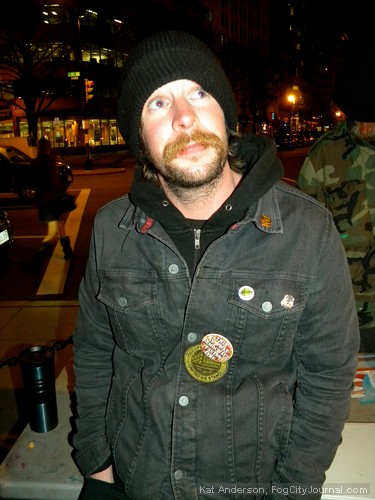
Robert Dilley, 26, a native of New Jersey, migrated to OccupyDC after Zuccotti Park got broken up by the NYPD. He found it too difficult to be homeless and a full-time activist in New York City. At OccupyDC, he has found a "home" where he says he is as "selfless as possible," and he offers what he has "to the community." Rich Coffman says that Dilley is a "logistics whiz" and is "the backbone of this camp."
Except for a single taser incident, protesters interviewed Friday by Fog City Journal couldn’t recall any clashes with the authorities. One Dallas protester brought some Texas twang to the scene, located in McPherson Square, a park a few blocks from the White House. Volunteers run a small library. On Friday there was a free dinner of donated stew and raspberry cheesecake. A couple of denizens smoked dope in a pipe fashioned from a whole red apple.
On Tuesday, U.S. District Judge James Boasberg ruled that park police could enforce a ban on sleeping or being in possession of camping gear in McPherson Square, saying that camping on public property was not an activity protected by the First Amendment. But on Friday, the tents remained. A big blue tarp, known to protesters as the “tent of dreams,” draped the pedestal beneath the big central statue honoring Civil War General James B. McPherson, for whom the park is named.
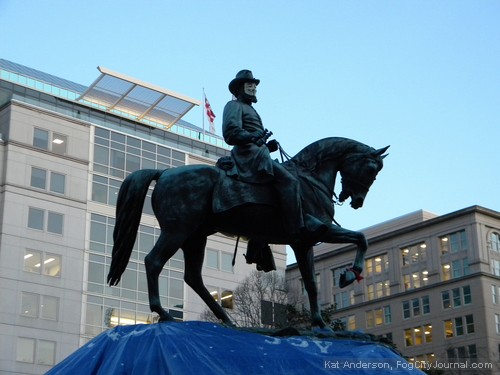
A statue honoring Civil War General James B. McPherson has been turned into a symbol of the Occupy DC protest.
Protesters winkingly denied there was any overnight sleeping going on in the hundred or so tents and tarps packed into the square, in deference to the rules. They had staged a “sleep strike,” taking turns prying each other’s eyelids open in the name of the 99 percent. As for what was going on inside the tarps, if not sleep, people were cagey.
“Some people have been accused of having sex or using drugs in those tents, but I’ve never seen any of that stuff going on,” Rich Coffman, 42, the Dallas protester, said.
Coffman held forth in a scavenged wooden chair at the edge of the square, near busy Vermont Avenue. Passersby ignored him for the most part, although a few smiled or gave a thumbs-up when they walked by. He advocated two main principles that he suggested everyone could practice — removing one’s money from any commercial bank that contributed to the housing crisis, and making “moral purchases.”
“If you’re afraid to take all your money out, take half out,” he said. “And even if you’re just buying a pair of socks, ask, “Where did these socks come from?””
The protesters here put a lot of emphasis on self-reliance and direct action they take pains to show in a positive light. They have forged solidarity from living outdoors together in the dead of winter, albeit a mild one this year. The hardiness seems to reflect a political philosophy as much as a choice of tactics. To some, it may appear to be a lifestyle choice for the chronically unemployed, but McPherson Square regulars carry some weight, perhaps befitting the massive public architecture of the city around them.
Coffman said it was time for people upset with the status quo to stop pointing fingers at others. “Start pointing your finger at yourself,” he said.
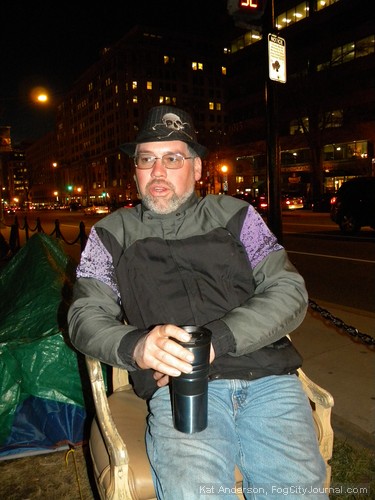
Rich Coffman, 42, a refugee of Dallas, was drawn to McPherson Square and the Occupy DC camp after the Texas police evicted the Dallas protesters in November after six weeks. "I followed what my head heart and gut told me to do," he said. He sat at the edge of the Washington, D.C., scene, displaying a distinctively Texas version of the Occupy Wall Street message: "Occupy y'all street" his sign reads.
Sara Otto, 37, a schoolteacher from the District, recalled quitting her job as a 9th grade English teacher when she became disenchanted by corporate influences she saw in the schools.
“It broke my heart,” she said. “Hedge funds are taking over schools and trading students like currency.”
Otto commutes to McPherson Square from her home, but she was part of the original encampment, which began October 2 last year. She participated enthusiastically in the daily General Assemblies, the non-hierarchical governance system that has been a hallmark of Occupy since the beginning. The meetings generated “amazing dialogue” at the beginning, she said, but lately, she’s become concerned that the system has broken down because facilitators — no one here is considered a “leader” — are too often attacked by some participants.
“The facilitators have endured a constant barrage,” she said, including accusations of being “democratic operatives” and “co-opting” the process.
But she said a little chaos and frustration is to be expected for a cause that only began in September. Any apparent drift or lack of clear direction doesn’t concern her at all.
Teachers, after all, have plenty of patience. Now, she hopes to put more public pressure against Wall Street, and thereby expose “hidden connections” that she said are undermining the schools with corporate influence.
“This is a young social movement starting to come out,” she said.
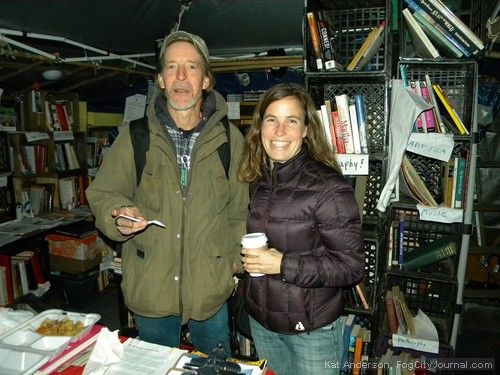
Sarah Otto, 37, a schoolteacher from Washington, D.C., often joins chum Eric Gustavson (left) at the Occupy DC camp in McPherson Square near the White House. She left her job teaching 9th grade English in the local public schools when she grew disenchanted by what she perceived as corporate meddling in education. "It broke my heart," she said. "Hedge funds are taking over schools and trading students like currency." She has been a regular at the park, and was part of the original encampment that began October 2. She hopes more public pressure will reveal hidden connections between Wall Street and the schools.
A few tents away, Coffman was similarly upbeat. He had heard some disturbing details about Occupy Oakland and clashes between protesters and police. Even if the powers-that-be win a few skirmishes, nobody at McPherson Square believed that would stop Occupy from becoming a true movement. A big action is in the works worldwide, planned for March 30 and culminating on May 1, the original labor day.
“You can cut all the roses, but you can’t stop the spring,” Coffman said.
More Info
Occupy DC at Wikipedia.


 The Hunger Site
The Hunger Site
February 4, 2012 at 10:57 am
There is no real protest without some degree of civil disobedience and no civil disobedience without some degree of violation of local ordinances – laws designed to protect the system and its status quo. Thus protest in action will require breaking laws and triggering an official response. In most parts of the world, the stronger and more brutal the response, the more stronger the resolve of the protesters. It remains to be seen whether that is also true here.
Meanwhile, over in our country, especially in the cold weather states, while the days get colder and the police response becomes harsher, those remaining in the occupy encampments will be either the most motivated, have the fewest alternate housing options and/or are the most justly enraged – an important but non representative cross section of Occupy.
This abused minority of participants will be used to misrepresent in the mainstream media the nature of the movement. They are already doing that now as a few bad actors within the movement are selectively focused on to discredit the larger cause.
For these reasons and more, for telling the truth, I think the above article about Occupy DC is important.
February 4, 2012 at 10:40 am
A well done article. I appreciated reading about the individual stories of some of the occupiers. Each story is interesting and compelling. The diversity of the participants in the Occupy movement gives it strength and reveals that the people demonstrating represent a broad cross section of society.
February 4, 2012 at 8:16 am
Police raided this morning, Saturday, 02.04: http://www.washingtonpost.com/local/occupy-dc-camp-raided-by-police/2012/02/04/gIQAwDoCpQ_story.html